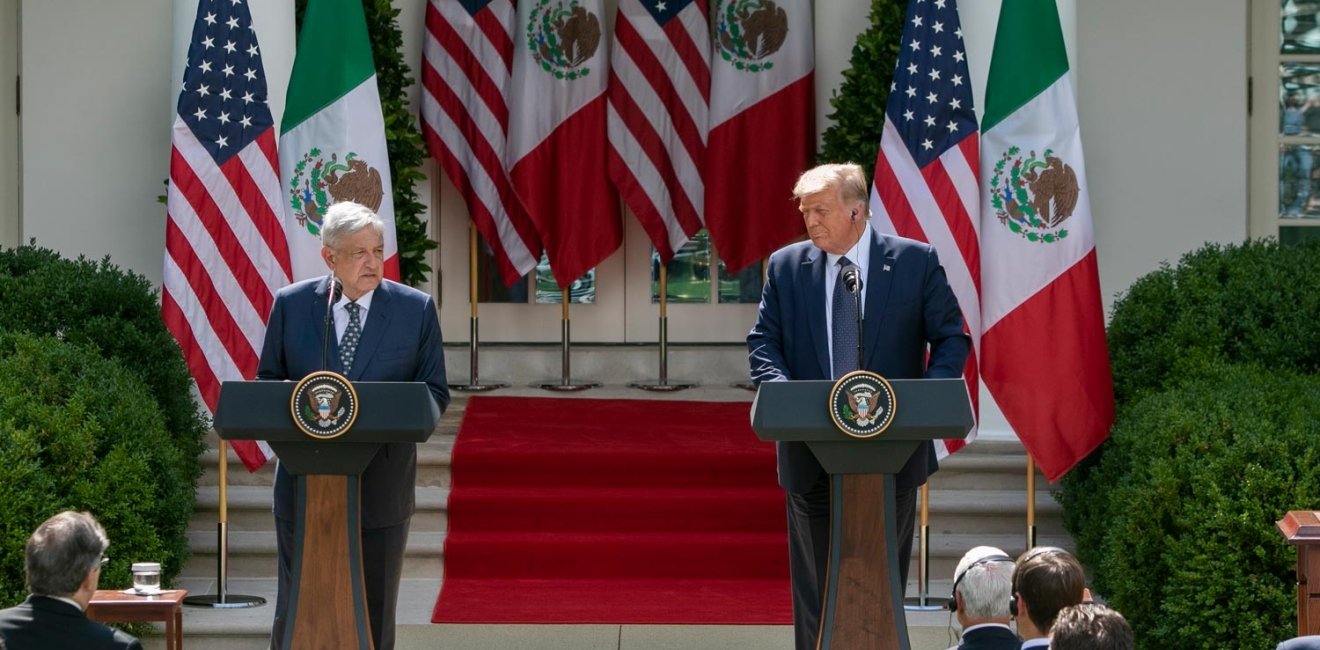When Mexican President Andrés Manuel López Obrador (AMLO) met U.S. President Donald Trump on July 8, the two leaders celebrated the new United States-Mexico-Canada agreement (USMCA) and exchanged positive messages about the state of relations between the neighbors and the economic opportunities ahead.
Acknowledging the friendly tone of the White House visit, there remains an important action agenda to improve prospects for commerce, security and wellbeing between the United States and Mexico, as well as with Canada, whose leader, Justin Trudeau, declined to join in the July 8 meeting.
The last 18 months of U.S.-Mexico relations have focused largely crisis management, dealing with Trump’s focus on building a border wall, managing the surge of Central American migrants headed to the United States, and searching for an agreement to better address the flows of lethal, illegal drugs northward and of arms and drug-sale profits southward, which fuels much suffering both in Mexico and the United States. In addition, there were many ups and downs in the USMCA negotiations.
The AMLO and Trump administrations found solutions along the way and were thus able to signal broad areas of agreement on July 8.
To the surprise of many, the AMLO and Trump administrations found solutions along the way and were thus able to signal broad areas of agreement on July 8. But they also still have much to gain if their teams can now build on the positive messages to solve concrete problems.
Both presidents face challenges. AMLO and Trump are both dropping in public opinion polls. Both are criticized for their handling of the covid-19 pandemic, and both sides of the border worry about the other as a source of infection. Trump and AMLO face serious economic downturns, negative GDP projections and high unemployment. AMLO is criticized for not managing well rising drug cartel violence, as highlighted by the recent attack on Mexico City’s police chief. Trump is criticized for his handling of justice and racial issues. Recent reports also suggest that U.S. drug overdoses are rising during the covid crisis, fueled by lethal illicit trafficking in heroin and fentanyl that continues to flow from Mexico.
Despite criticism of AMLO for the U.S. visit, the two governments can use the improved atmosphere to promote economic recovery and to better address security and border management, which are essential for economic opportunities to reach their potential. In the short term, this can be manifested in solving concrete problems that companies are facing, specific steps to improve supply chain management between the countries, increasing cooperation against covid-19, especially in the border region, and in intensifying efforts to crack down on the flow of illicit drugs northward and the illicit flows of arms and money southward.
On the economic front, the USMCA offers at least 16 years of agreed rules and processes that will allow businesses, farmers and workers across North America to strengthen the existing networks that produced $1.3 trillion in trade in 2019. This commerce supports up to 12 million jobs in the United States and millions more in Mexico and Canada, which are the U.S.’s Number One and Number Two trading partners.
The USMCA’s updated rules, norms and procedures will facilitate trade and investment, as well as the ability to resolve disputes that arise midst the $2 million-a-minute trade cross the U.S.’s borders with Canada and Mexico.
The USMCA’s updated rules, norms and procedures will facilitate trade and investment, as well as the ability to resolve disputes that arise midst the $2 million-a-minute trade cross the U.S.’s borders with Canada and Mexico.
In the very short term, the three governments and their trade units need to focus on implementing the new rules and addressing areas where governments and businesses fall short on USMCA commitments. Dealing with concrete problems that arise should be a priority.
The value of the USMCA, however, goes beyond its ability to enforce rules and resolve differences, as important as that is. The USMCA should be seen a strategic vehicle for opening new opportunities for all three member countries and North America. The agreement has specific elements that encourage the three governments to find new ways to make their economies more competitive against other global commercial powers. The USMCA can enhance collaboration across the continent, for example, in dealing with the rapid changes sweeping through workplaces via the seemingly constant arrival of new technologies. These were already transforming jobs and businesses, and the covid crisis is accelerating the use of new technologies and doing business via the internet.
The USMCA offers guidelines for how to deal with internet-based commerce and data flows, which are likely to be even more important for economies in the years ahead.
The USMCA creates a new Committee on Competitiveness in which the three governments, ideally along with nongovernment “stakeholders,” can identify ways to make the region more efficient, productive and collaborative in dealing with shared problems. The USMCA offers guidelines for how to deal with internet-based commerce and data flows, which are likely to be even more important for economies in the years ahead. There are provisions that require cooperation on labor issues and encourage dialogue on work-based learning to help provide skills for incoming and existing workers. The USMCA boosts joint efforts to help small- and medium-sized businesses to buy and sell more across the continent, urges regulators to work more collaboratively to lower costs while assuring safety, and does much more.
The USMCA embodies a broad action agenda that encourages cooperation among the three governments. That collaboration should go far beyond trade agencies or specific trade provisions. And, a focus on building longer term cooperation can help the U.S., Mexican and Canadian economies rebound from the covid-19 downturn.
Mexico has a particular opportunity to attract new investment with the USMCA’s launch, and as investors consider making supply chains shorter and more resilient following the effects from covid-19. Mexico and the United States need to establish better mechanisms for coordinating on supply chain management, especially in emergencies. During covid-19 shutdowns, the two governments did not coordinate well about how to keep essential supply chains open, sending negative signals to key sectors in both countries. Such a coordinating mechanism should help improve efficiencies in normal times too.
Mexico also needs to promote an environment attracting investors that builds on the advantages of its location next to the United States. AMLO’s government, however, has taken steps that generated alarm among U.S. and other international investors, sparking companies, business associations and regulators to go to court for help and to prompt concerns publicly, including appeals for Trump to raise energy issues with AMLO. In addition, the U.S. Trade Representative told the U.S. Congress that he will be very attentive to Mexico’s obligations under the USMCA, and many expect early challenges to Mexico regarding its labor rights commitments, leading some to warn that Mexico faces USMCA storms ahead.
Mexico’s government should focus on addressing specific problems and concerns raised, with the goal of generating job-creating investment and economic growth under the USMCA’s framework and in light of the interest in near-shoring supply chains.
It is important to recall that the GDP of the U.S.-Mexico border states if combined together would amount to the third-largest economy in the world.
Given the good atmosphere from the July 8 visit, the Trump and AMLO teams could also usefully develop a positive, forward-looking economic agenda with the aim of resolving potential problems before they become formal disputes. The two administrations could devise initiatives to facilitate economic opportunities and job creation, for example, focused on border states and infrastructure, which will facilitate trade. It is important to recall that the GDP of the U.S.-Mexico border states if combined together would amount to the third-largest economy in the world. The potential for gain from increased economic integration is significant.
To support economic initiatives, the governments also need to address more effectively the multibillion-dollar cross-border crime, involving drugs, illicit money, guns and irregular migration. Bilateral security cooperation has been in low gear, and many thousands of Americans and Mexicans are paying very dearly for the shortfall in effective bilateral anti-crime collaboration. While it is not realistic to see a great deal of progress on migration issues at this time, taking a longer-term approach that addresses root causes and not just enforcement should also be an important item on the U.S.-Mexico action agenda.
The bottom line is that to tap into the potential for strengthening mutual prosperity inherent in the USMCA, Mexico and the United States need to be actively engaged on broad future-oriented agenda. That work is still on the table.
Author

Former Career Ambassador to Afghanistan, Argentina, and Mexico; Distinguished Diplomat in Residence, School of International Service, American University

Mexico Institute
The Mexico Institute seeks to improve understanding, communication, and cooperation between Mexico and the United States by promoting original research, encouraging public discussion, and proposing policy options for enhancing the bilateral relationship. A binational Advisory Board, chaired by Luis Téllez and Earl Anthony Wayne, oversees the work of the Mexico Institute. Read more





